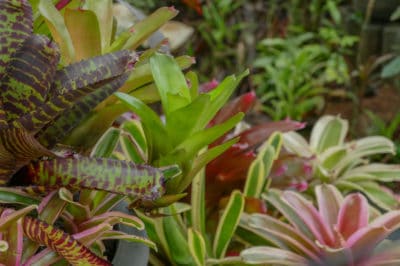About Bromeliads
The bromeliad group includes more than 3,000 species. The common pineapple is probably the most easily recognized. Like orchids, many bromeliads grow in trees and get their nourishment from the air, rainfall and insects rather than soil. What all bromeliads do need is warmth and good air circulation. Many can be grown indoors. Some may also do well outside in UDSA Zones 9 and higher.
Types of Bromeliads
The growth style of a bromeliad has an effect on its care. Here are the three major groups:
- Terrestrial – the pineapple is a good representative; ground growers, they take in water and nutrients through roots.
- Saxicolous – lichens represent this group; they attach themselves to rocks – no soil needed.
- Epiphytic – like Spanish moss, these hang from trees and get water and nutrients primarily from the air.
Temperature for Bromeliads
Most bromeliads are tropical or subtropical plants. Temperature should range from 70 to 90 °F (21 to 32°C) in the daytime and 50 to 70 °F (10 to 21°C) at night. Outdoor plants may need protection in winter. Bilbergias, Aechmeas and Neoregelias are usually hardy to about 30 to 32 °F (°C). Cryptanthus and Gusmania varieties are not hardy and need temperatures above 45°F (7°C).
Light for Bromeliads
The bromeliads you grow as houseplants typically need bright but indirect light. A shade cloth over a greenhouse or a translucent shade on a south-facing window provide good places for these plants. Some can tolerate full sun or dappled shade. Generally speaking, those with thick, hard, gray-green leaves can handle a full day in the sun and those with delicate, softer leaves can handle shade.
Watering Bromeliads
Bromeliads should be watered well and then allowed to dry out. Mist regularly to keep humidity up. Dunk air plants in a bowl and let them sit for about 10 minutes before removing. In order of preference use rainwater, reverse osmosis water, distilled water or filtered water. Tap water may be hard or contain chlorine and fluoride. Softened water can damage plants.
Feeding Bromeliads
Most terrestrial bromeliads do better with time-release fertilizer sprinkled on the soil at the plant base. However, some should be sprayed with dilute liquid fertilizer several times during the growing season. Flush tank bromeliads periodically to prevent stagnant water and salts. Never place fertilizer pellets or powder in the tank. High nitrogen fertilizer will promote leaf growth rather than flowering.
